Conure - Mitred
Scientific Name: Aratinga mitrata mitrata
Fri, 4th April, 2025 - 4:13 pm GMT
Sponsor Ads:

Alternative Name
Scientific Name: Aratinga mitrata mitrataBasic Info
Mitred Conures grow to a length of about 15 inches and are larger than some parrot species! They have incredibly long tail feathers and rather stocky bodies. The plumage of Mitred Conures is predominantly green, with the breast and abdomen areas paler. Red coloration covers the forehead, crown and eye areas and random red feathers are strewn throughout the head, neck, face, abdomen and breast areas. The undersides of the flight and tail feathers are a dull olive yellow, as are the larger underwing coverts. The iris of a Mitred Conure is golden brown, and the periopthalmic ring is white. Mitred Conures have tan feet and horn-colored bills.
Health
They love bathing and need a variety of chew toys to keep them from becoming bored. Mitred Conures should be fed a good seed mix with some sprouted seeds. They also need a variety of fruits and vegetables or green foods. You should also feed them a vitamin and mineral supplement regularly. Mitred Conures flourish in outdoor aviaries that are about 12 feet by three feet by six feet. Although they can tolerate fairly cold temperatures, they should have an adjoining indoor structure and a warm nesting box. Breeding In the wild, Mitred Conures breed in the winter months. They make nests in hollow, dead trees and line them with old bark. Generally, a clutch consists of about two eggs. Immature Mitred Conures have darker irises than adults and have less red plumage.Habitat
Found in northwestern Argentina and eastern BoliviaBehavior
Establishing a population in Los Angeles of significant numbers of escaped pets, the Mitred Conure of South America is transplanting itself with accidental human help! In fact a wild flock was even reported to be thriving in Brooklyn, New York in spite of the freezing temperatures. Mitred Conures are very affectionate, intelligent birds and get along well with other Conures. They can learn a variety of words and phrases, and love nothing better than playing or cuddling with their owners. In the wild, Mitred Conures flock together in large numbers, which is why they love company in captivity. They love bathing and need a variety of chew toys to keep them from becoming bored. Flowering branches are always appreciated by Mitred Conures, just make sure that they are not going to be poisonous to your new friend. Mitred Conures are very curious, playful birds and are fun to watch as well as to interact with!Origin
South AmericaHistory
Originating in Peru, Mitred Conures are also found in northwestern Argentina and eastern Bolivia. They were first noted by Tschudi in 1844. Today, Mitred Conures are very popular as pets. They are studied closely in the United States because escaped pets have formed a flock of about 40 birds that live in Los Angeles and they function much as wild South American Conures will. It is speculated that they may start an American population.Common Foods
Mitred Conures should be fed a good seed mix with some sprouted seeds. They also need a variety of fruits and vegetables or green foods.Sponsor Ads:
Policemen with private motives are dangerous. -- Unknown
Conure - Mitred
Coded by: BGID® | ALL RIGHTS RESERVED Copyright © 2000-2025
Disclaimer | Privacy | Report Errors / Contact | Credits










